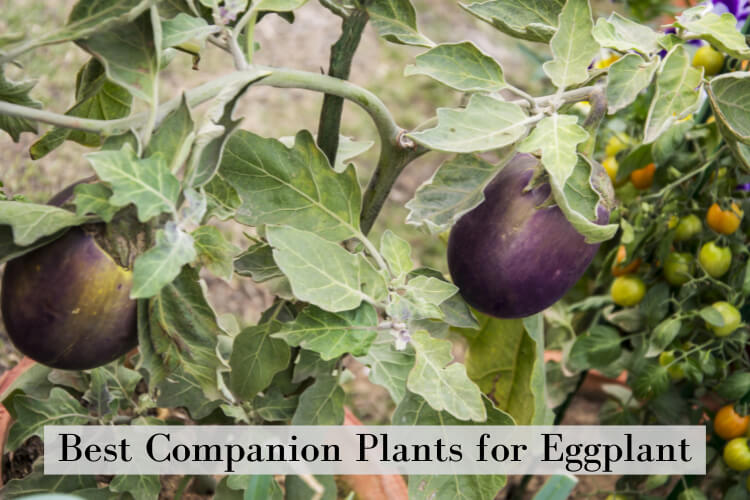In my opinion, eggplants in general don’t get the love they deserve. They can seem a little intimidating to grow- but as long as you plant them in the right spot in your garden, they can produce a delicious harvest without too much effort on your part. And one of the smartest ways to maximize garden space and overall yield is with companion planting.
Ideal eggplant companion plants have similar care requirements, attract beneficial garden insects or repel harmful ones. Tomatoes, peppers of all varieties, nasturtium, marigold, herbs, leafy greens, beans, cucumbers, garlic, and borage are some of the best choices. Plants that make poor companion plants for eggplant include fennel, brassicas, potatoes, heavy-feeding plants, and geranium.
In this post, you’ll learn the details of my top recommendations for which plants to select as eggplant companions, why they’re helpful, and some care tips to keep both plants healthy. Not every plant makes a friendly neighbor for eggplant, so we’ll also go over which plants to grow on the other side of the garden.
Let’s get started!
Table of Contents
What Is Companion Planting?
Companion planting is the practice of placing compatible plants near one another in the garden, with the goal of boosting growth/production in both plants or one plant bringing specific benefits to the other.
The eggplant life cycle consists of several stages, and at one point or another, eggplants have a few key needs:
- They’re a fairly large plant, often getting 2-3 feet across.
- They need lots of nutrients to produce healthy, tasty fruits.
- They love the sun and warm temperatures.
- They need lots of moisture.
- They rely on insects or the breeze to pollinate the flowers.
- They are vulnerable to certain pests and diseases that can decimate your crop.
Thoughtful companion planting helps you place plants that need similar sun exposure, watering, and fertilizing close together, so you can more easily and quickly care for both plants. Also, some plants have the power to draw pollinators or repel pests, so your eggplants can develop and grow to a good size.
This video from Grow Veg does a great summary:
13 Best Eggplant Companion Plants
Now that we’ve covered the “why” behind eggplant companion planting, let’s get to which plants make good neighbors.
1. Tomatoes

Eggplants and tomatoes are members of the same plant family, the Solanaceae family, also called nightshades. Since they’re such close relatives, tomatoes are eggplant have nearly identical growing conditions, so you can capitalize on that sunny patch of ground with a dual tomato and eggplant harvest.
One caution: Eggplant likes 6 or more hours of sun, so plant eggplants in a position where tomatoes will not cause too much shade.
Care tips for tomatoes:
- Support tomatoes with a large, sturdy tomato cage. Don’t make the mistake I’ve made before of waiting too long to set up your cage- place it as soon as you plant your seedlings.
- Suckers (small stems that grow from the stem junctures) don’t produce any fruits, so prune them off to direct energy to the fruiting branches.
- Keep an eye out for tomato hornworms that can cause lots of damage to both tomatoes and eggplant. Pluck them off by hand and plant flowering herbs and plants that can draw beneficial predators.
2. Peppers (All Kinds)

Like tomatoes and eggplant, peppers also belong to the nightshade family, making them another ideal, easy-care eggplant companion plant. Whether you prefer sweet bell peppers or hot peppers, pepper plants of all varieties make good neighbors for eggplant.
Care tips for peppers:
- Some larger pepper varieties can benefit from support like a cage or trellis.
- Provide light shade with a structure or strategically placed eggplant if temperatures stay above 90 degrees Fahrenheit to prevent sunscald.
3. Nasturtium
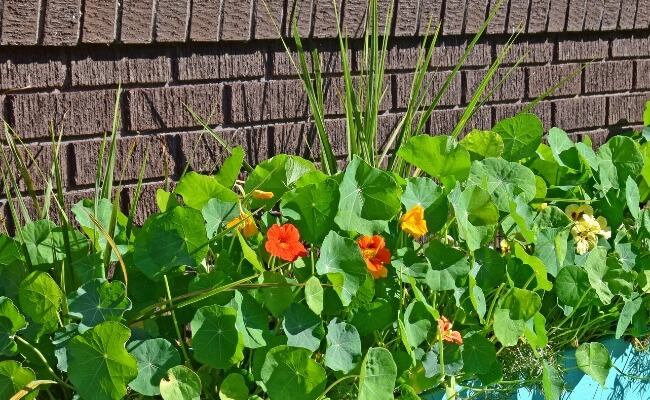
Nasturtium is one of my personal favorite companion plants- I’ve always found it to be a great neighbor to just about any vegetable or herb plant.
Pests can be a cause or unhealthy yellow eggplant leaves, but nasturtiums can help keep that problem at bay. The blossom fragrance attracts aphids and whiteflies, so nasturtium acts a trap crop that keeps pests away from eggplants.
The vibrant flowers also attract predatory insects that feast on pests that would otherwise infest eggplants. And as a ground cover, nasturtium keeps soil cool and helps retain moisture.
Care tips for nasturtium:
- Nasturtium only needs 3 to 6 hours of sunlight, so don’t worry if it gets a bit shaded out by the eggplant leaves.
- As a scrappy grower that thrives even in nutrient-poor soil, nasturtium won’t compete with heavy-feeding eggplant for soil nutrients.
4. Marigolds
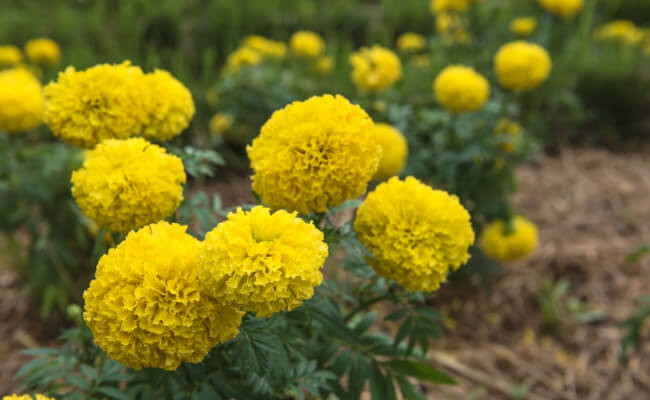
Marigolds are another of my favorite companion plants- for eggplants or almost any plant. That’s because they attract pollinators that increase yields as well as predatory insects that deter eggplant pests including beetles and aphids.
Marigold flowers secrete a compound called limonene, which is an effective deterrent for pests that plague nightshades- whiteflies in particular, according to Newcastle University.
Scientific studies have also found that marigold roots secrete alpha-terthienyl, which is known to kill nematodes.
Care tips for marigolds:
- Marigolds thrive in full sun and well-draining soil and need consistent, even watering.
- Deadhead spent blooms to encourage more blooming and further deter pests.
5. Herbs
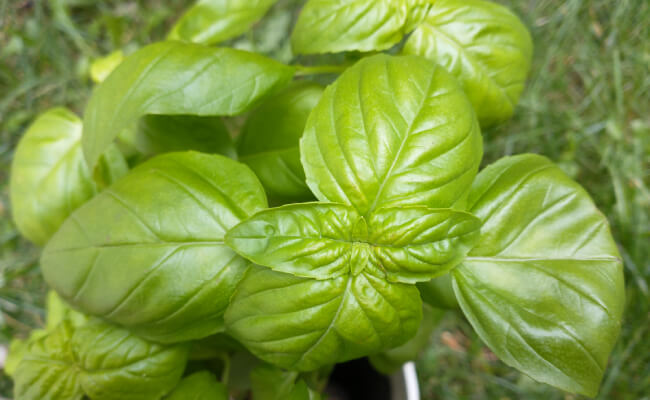
Fragrant herbs like basil, oregano, thyme, and tarragon are great companion plants for eggplant because they repel pests while attracting predatory insects and pollinators. Most herbs thrive in full sun to partial shade and won’t compete with eggplant for soil nutrients.
Care tips for herbs:
- Limit herb companion plants for eggplant to only a couple because some (especially mint and oregano) can quickly take over a garden.
- Keep herbs trimmed back to prevent overgrowth and add flavor to recipes.
6. Lettuce and Leafy Greens

Leafy greens like lettuce, Swiss chard, bok choy, and spinach are great for ground cover, both preventing weeds and helping the soil retain moisture to nourish your eggplants. In return, an eggplant’s large leaves provide leafy greens with shade when it’s hot, which can increase your yield of lettuce and spinach.
Care tips for leafy greens:
- Apply mulch around both eggplant and leafy greens to maintain soil moisture and prevent soil from getting hot for the greens.
- For lots of leafy greens, plant a variety of the different types and cut to crown using sharp scissors when plants are 6-10 inches high.
RELATED: Companion planting is just one facet of growing eggplants. Learn everything you need to know on how to grow eggplant for a bumper crop!
7. Beans

Beans, both bush and pole types, are nitrogen-fixing plants, meaning that they release nitrogen into the soil through their root systems. This provides a boost of nutrition for heavy-feeding eggplant, and it also means there’s no competition for nutrients with beans and eggplants.
Care tips for beans:
- Train pole beans on a trellis or fence line to save space.
- If you don’t have a support structure handy, choose compact-growing bush beans.
- Direct seed beans as their fragile roots don’t transplant well.
8. Borage
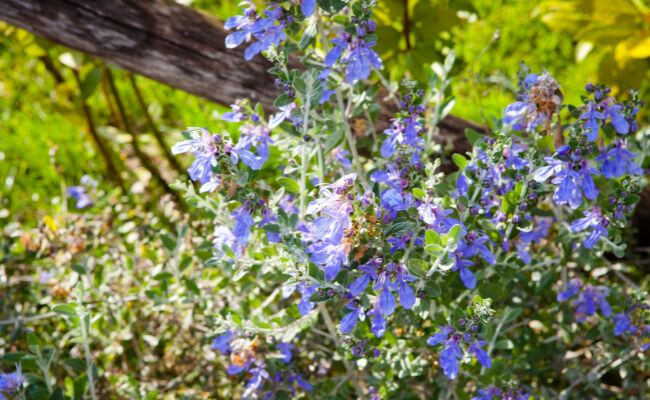
Borage has beautiful blue star-shaped flowers that attract predatory insects and pollinators- meaning a better eggplant yield and fewer pests. It is especially good for deterring armyworms, cabbage worms, and tomato hornworms. Borage roots can also pull trace minerals from the deeper soil to provide for vegetable plants with more shallow roots.
Care tips for borage:
- Borage is edible, but the stems produce fine spikes as they mature. These spikes can cause skin irritation, so keep children and pets away from borage leaves to prevent rash.
- Borage is an enthusiastic self-seeder, so grow it in a pot near your eggplants if you don’t want a perennial borage patch.
9. Garlic

Garlic makes a great eggplant companion plant because its scent repels aphids, flea beetles, caterpillars, mites, slugs, and whiteflies. Since both garlic and eggplant love the sun, planting them together maximizes garden space. Plus they work great together in recipes!
Care tips for garlic:
- Plant garlic in the fall, leaving plenty of space in between to accommodate your eggplants in the spring.
- Take care to not disturb bulbs when planting eggplant seedlings.
10. Cucumbers
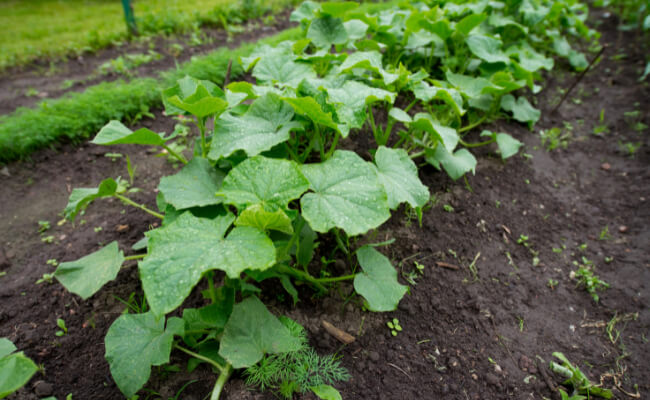
Cucumbers make good eggplant companion plants due to similar growing conditions: Both plants enjoy lots of sunshine, soil rich in nutrients, and moist, well-draining ground.
Cucumber grows fast, so prevent any shade from the cucumber plant on eggplant with strategic planting and support. You could also choose a bush variety to save a little space.
Care tips for cucumbers:
- Support cucumber plants with a trellis to keep fruit off the ground and away from slugs, as well as to save garden space.
- Fertilize both cucumbers and eggplant every 3 weeks.
11. Peas
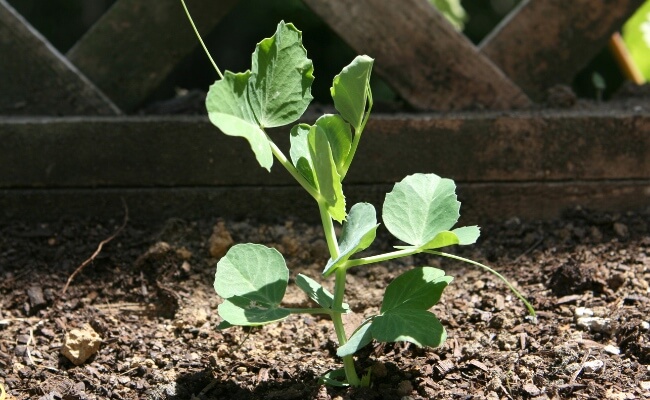
Peas are excellent at deterring pests and adding nitrogen to your soil, which is highly beneficial to eggplant as they need lots of feeding. This improves eggplant vigor and maximizes garden space.
Care tips for peas:
- Train peas on a trellis to save space.
- Plant peas in spring about a month before the last frost for the area and again in late summer for an additional harvest.
12. Onions

Thanks to their strong fragrance, onions naturally deter aphids, whiteflies, and beetles. Because they grow shallow in soil, there won’t be competition with eggplant for resources.
Care tips for onions:
- Plant onions in early spring, as soon as you’re able to work the soil. Leave enough space between onions to plant eggplant later in the spring.
- Keep soil moist for onions’ shallow roots as well as moist-soil-loving eggplant.
13. Radishes

Not only are they easy to grow, but radishes are very productive and produce a crop quickly- many varieties mature in as little as 35-45 days. Radishes are also small plants, so they help maximize garden space without too much competition with eggplant.
Care tips for radishes:
- Radishes are extremely fast growers, usually maturing in 35-45 days. Plant new radishes every 10 days to maintain the eggplant companion planting and consistent produce for salads and other recipes.
- Most radish varieties prefer cool temperatures. The large eggplant leaves can help provide shade, but it’s a good idea to choose heat-tolerant varieties if you live in a hot climate.
5 Worst Eggplant Companion Plants
1. Fennel
Fennel is not a good companion plant for eggplant- in fact, it’s a poor companion to pretty much any garden plant. The reason is that fennel forms a deep taproot that saps soil nutrients, and it also releases compounds that kill some plants.
Fennel is still a great plant to have in your garden- it just needs plenty of personal space!
2. Brassicas
Brassicas don’t do well as eggplant companion plants because they grow in neutral soil while eggplant prefers slightly acidic soil. The large brassica family includes:
- Cabbage
- Broccoli
- Kale
- Cauliflower
Brassicas also tend to attract cabbage loopers. While they may not be a big threat to eggplant fruits, they can cause noticeable damage to the leaves.
3. Potatoes
Even though they’re both members of the nightshade plant family, don’t plant your eggplant near potatoes. Potato plants are known to attract Colorado potato beetle, which The University of Minnesota Extension lists as a threat to eggplant, tomatoes, and peppers.
4. Heavy-Feeding Plants
Eggplants need lots of sun, water, and nutrients to produce their large, moisture-rich fruits, and they will not produce well if they have to compete with other similarly heavy-feeding plants.
These all make bad eggplant companion plants because they rob the soil of nutrients:
- Pumpkins
- Melons
- Zucchini
- Corn
5. Geranium
As much as I love geranium, it can host several diseases like blight and bacterial wilt that can spread to eggplant. So keep your pretty geraniums on the front porch- away from the vegetable garden!

Frequently Asked Questions about Eggplant Companion Plants
Final Thoughts
Through my experience, I’ve found that companion planting is an easy way to simplify my garden work and have healthier plants at the same time. Eggplant has many friends to choose from, so I hope you’ve found this helpful and inspiring for your eggplant garden this year!
I’d love to hear from you! Do you have any other questions about companion plants for eggplants, or maybe you’ve discovered some good ones that aren’t on my list? Either way, there’s always more to learn from each other, so please feel free to share in the comments!

